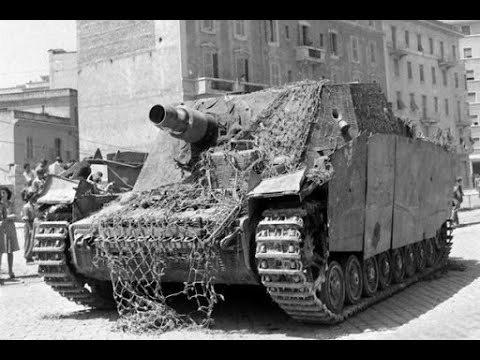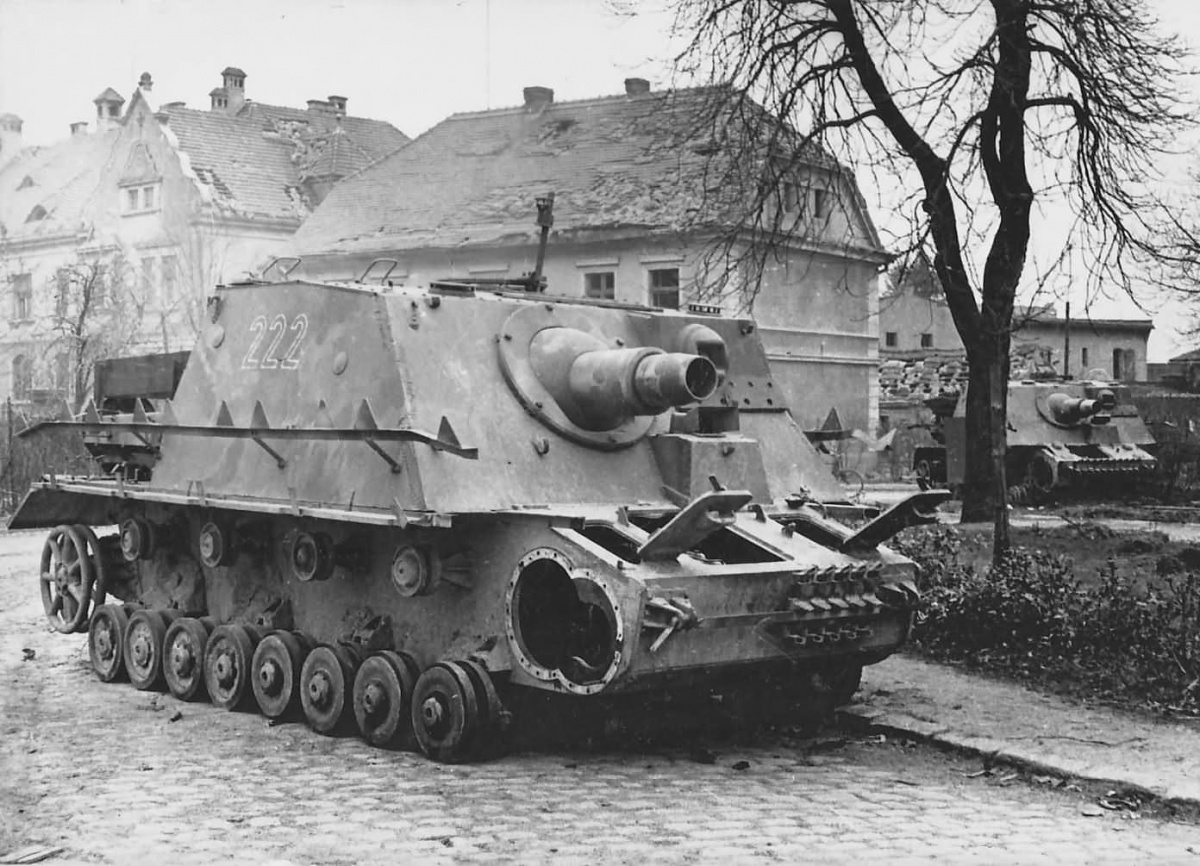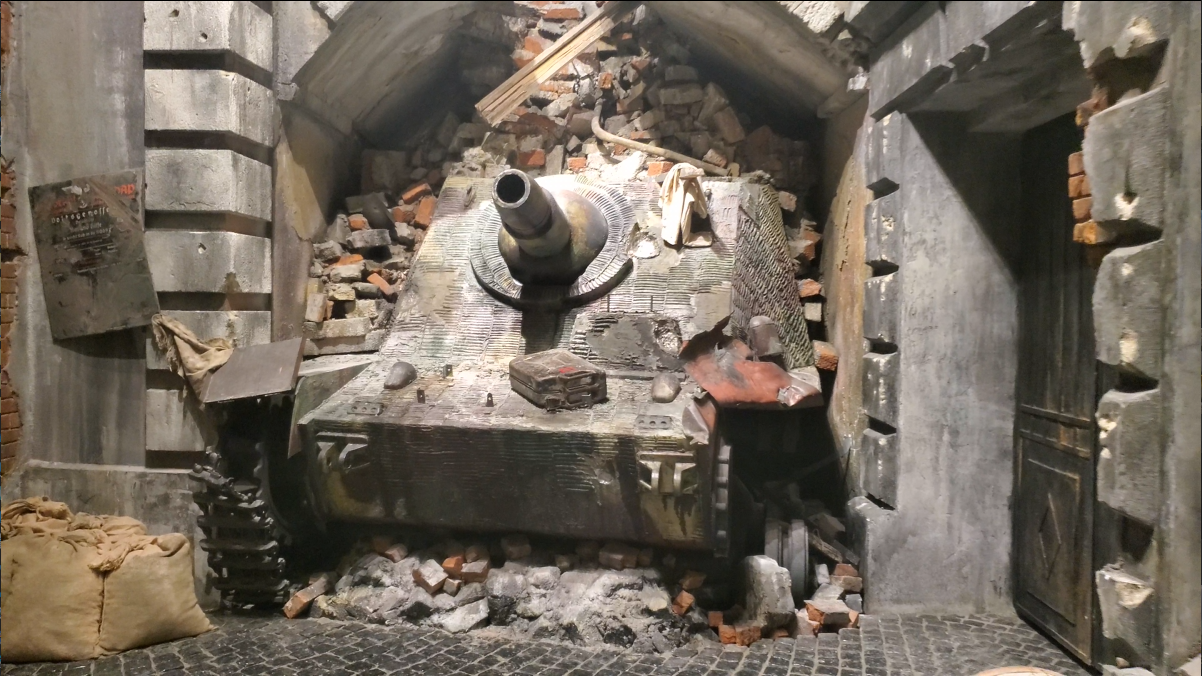The Sturmpanzer IV Assault Gun
The Sturmpanzer IV is a medium-weight German self-propelled artillery mount (ACS) of the assault gun class of World War II based on the Panzer IV medium tank. It was used in the battles near Kursk, in Anzio, Normandy, and helped in the suppression of the uprising in Warsaw. Serially produced since April 1943, before the surrender of Germany, 302 copies were produced. They were distributed among four separate assault tank battalions.
The official German name is Sturmpanzer IV (Sturmpanzer IV). According to the departmental rubricator of the Ministry of Armaments of Nazi Germany, the self-propelled gun was designated as Sd.Kfz. 166.
There is a name Sturmpanzer 43, where the numbers indicate the beginning of the production of the machine, 1943. German soldiers among themselves called the car simply “Shtupa” (StuPa) – short for the official Sturmpanzer. But more famous is the nickname “Brummbär” (from German - ”grumbler”, transliterated as “Brummber”), given by Allied intelligence, which was not used by the Germans themselves. In Soviet documents of that time, this self-propelled guns was designated as “Bear”.
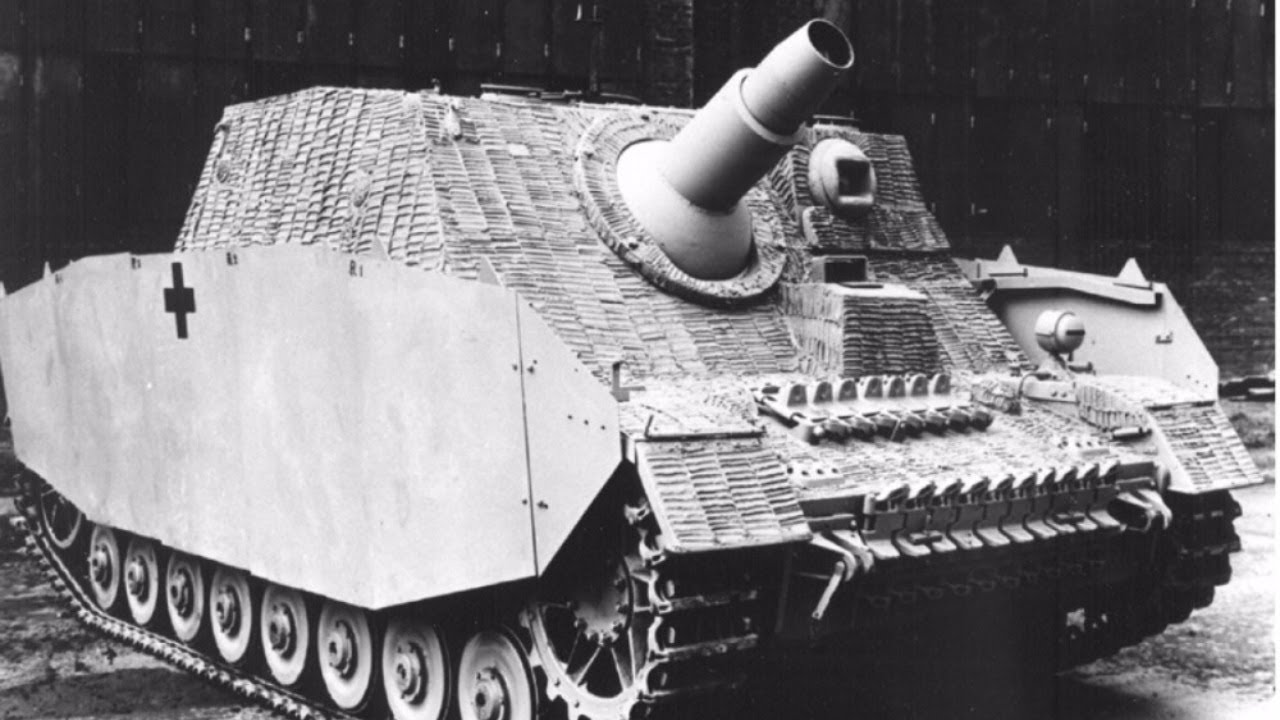 The Sturmpanzer was a development of the Panzer IV and was intended to provide close fire support to infantry, especially in urban areas. The Panzer IV chassis with the upper part of the hull was used as the base, while the turret was replaced by a new armored closed superstructure – the wheelhouse. The new gun was the 150 mm (5.9 in) Sturmhaubitze (StuH) 43 L/12 developed by Škoda. It fired the same rounds as the 15 cm sIG 33 heavy infantry gun. Carried ammunition was 38 rounds of separate-sleeve loading. For aiming, an optical sight Sfl.Zf was used. 1a. Due to the combined weight of the projectile and cartridge case, the work of the loader was difficult, especially if the gun was raised to a high angle of fire (38 kg high-explosive fragmentation projectile and 8 kg cartridge case).
The Sturmpanzer was a development of the Panzer IV and was intended to provide close fire support to infantry, especially in urban areas. The Panzer IV chassis with the upper part of the hull was used as the base, while the turret was replaced by a new armored closed superstructure – the wheelhouse. The new gun was the 150 mm (5.9 in) Sturmhaubitze (StuH) 43 L/12 developed by Škoda. It fired the same rounds as the 15 cm sIG 33 heavy infantry gun. Carried ammunition was 38 rounds of separate-sleeve loading. For aiming, an optical sight Sfl.Zf was used. 1a. Due to the combined weight of the projectile and cartridge case, the work of the loader was difficult, especially if the gun was raised to a high angle of fire (38 kg high-explosive fragmentation projectile and 8 kg cartridge case).
A transportable MG 34 machine gun can be mounted in the loader’s open hatch, similar to the location on the StuG III Ausf. G. Early vehicles had the MP 40 submachine gun, which could be fired through the pistol ports in the wheelhouse.
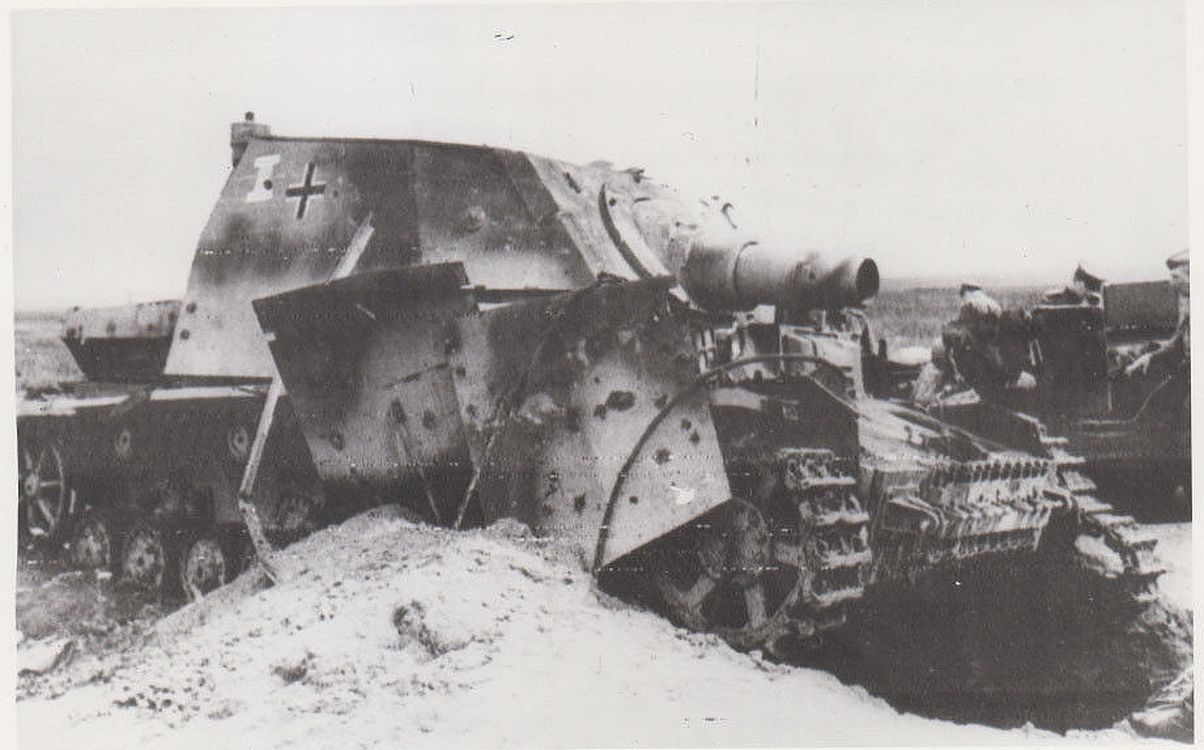 In early vehicles, the driver looked through a Fahrersehklappe 80 viewing device (similar to the Tiger)located in the superstructure protruding forward from the inclined front armor plate of the wheelhouse. The fighting compartment of the vehicles of the first series was ventilated (poorly) by a draft that came out in the rear of the cabin through two armored covers. Side 5-mm screens were installed on all copies, starting from the second series, screens of a new design appeared.
In early vehicles, the driver looked through a Fahrersehklappe 80 viewing device (similar to the Tiger)located in the superstructure protruding forward from the inclined front armor plate of the wheelhouse. The fighting compartment of the vehicles of the first series was ventilated (poorly) by a draft that came out in the rear of the cabin through two armored covers. Side 5-mm screens were installed on all copies, starting from the second series, screens of a new design appeared.
Early stormpanzers were too heavy for the original chassis, resulting in frequent suspension and transmission failures. In the second series, attempts were made to improve the situation with some success.
In October 1943 it was decided that the StuH 43 gun needed to be redesigned to reduce its weight. The new version, designated StuH 43/1, is about 800 kilograms lighter than the StuH 43. The weight was reduced in part by reducing the armor on the gun mount. This gun was installed starting from the third series.
Until September 1944, all vehicles were covered with a zimmerite coating.
It was the only vehicle of the Second World War, which turned out to be close in characteristics to the Soviet self-propelled gun SU-152.
Production series
First Series
Production of the first series of 60 pieces began in April 1943. For their manufacture, repair chassis were used.
The surviving machines, about half, since December 1943 were rebuilt, mostly to the standards of the second series.
Second Series
Restarted in December 1943, production continued until January 1944, 20 examples were built on repair chassis. After the baptism of fire on the Kursk Bulge, it turned out that the driver’s seat was too weakly protected, and it was reinforced. The gunner’s hatch was removed, and a fan was installed to facilitate the work of the crew. The number of transportable spare rollers has increased due to breakdowns due to overloading the machine. Cars were covered with zimmerite.
Third Series
The production of the third series continued from January to June 1944 with some design changes to the second series. Chassis used new Ausf. The H. Fahrersehklappe 80 was replaced by a periscope, and the lighter gun StuH 43/1 was used. Cars were covered with zimmerite. Released 60 copies.
Fourth Series
The cabin was redesigned in early 1944 for the fourth series, which used the chassis and engine HL120TRM112 from Ausf. J. Sturmpanzers of this series were produced from June 1944 to March 1945. Chassis were made at Nibelungenwerke. A total of 162 cars were assembled. The gun received a new casing, and the cabin became lower. In the frontal part of the wheelhouse, a MG 34 machine gun (600 rounds of ammunition) was installed in a ball mount. The place of the commander was improved by installing a turret from Sturmgeschütz III Ausf. G, a machine gun for air defense could be mounted on the turret. Due to suspension failures, non-rubber road wheels were installed to reduce the load on the suspension, which was a common occurrence. Cars were covered with Zimmerite until September 1944.
History of the battle path
Sturmpanzer-Abteilung 216
The first unit to receive the Sturmpanzer for combat was the 216th Assault Tank Battalion. It was formed at the end of April 1943 and moved to Amiens at the beginning of May to learn new assault guns. It was organized into 3 line companies, each with 14 vehicles, and a battalion headquarters with 3 vehicles. The battalion arrived in Central Russia on June 10, 1943 to prepare for Operation Citadel, the German attack on the Kursk Bulge. For this performance, the 216th battalion was temporarily assigned as the third schweres Panzerjäger Regiment 656 battalion (656th heavy anti-tank regiment) under the command of the 9th Army from Army Group Center.
The battalion remained in the area of Orel and Bryansk until it moved to the vicinity of Dnepropetrovsk and Zaporizhia at the end of August. The self-propelled guns were repaired and remained there until the Zaporozhye bridgehead was abandoned on October 15th. The battalion retreated to Nikopol, where it helped defend the German uprising until it was recalled to Germany at the end of December.
The Allied landing at Anzio on 22 January 1944 forced the battalion, completely independently, to move in early February with 28 vehicles to participate in the planned counterattack against the Allied beachhead, Unternehmen Fischfang (Operation Fishing). It was a mistake in the tasks, but the battalion remained in Italy until the end of the war. The battalion had 42 more vehicles available when the Allies launched their Northern Italian Operation in April 1945. But by the surrender of Germany, all copies were blown up to prevent capture, or lost during the retreat.
Sturmpanzer-Abteilung 217
The 217th assault tank battalion was formed on April 20, 1944 at the Grafenwöhr training ground from the soldiers of Panzer-Kompanie 40 and Panzer-Ersatz Abteilung 18. The battalion was formed without any armored fighting vehicles, the delivery of 19 navigators took place only at the end of May. In mid-July, the battalion went to the Normandy front. But had to disembark at Condé-sur-Noireau, about 170 km from the front line, because the Allies had badly damaged the French railway network. Many of the battalion’s vehicles broke down during the march to the front line. The first mention of the participation of the navigator in the battles is dated August 7 near Caen.. On August 19, the battalion had 17 serviceable vehicles and 14 more in service. Most of the battalion was not trapped in the Falaise pocket and managed to retreat to the northeast. The battalion had only 22 vehicles in October, which were divided between the 1st and 2nd companies; excess crews were sent to Panzer-Ersatz Abteilung 18. Further, the stormtroopers participated in the Ardennes operation, advancing only as far as Saint-Vith. The battalion was in constant retreat until the end of the war and was captured in the Ruhr Sack in April 1945.
Sturmpanzer-Kompanie zbV 218
Sturmpanzer-Kompanie zbV 218 (218th Special Purpose Assault Tank Company) was created in August 1944. He made his way to Warsaw, where he was attached to Panzer Abteilung (Fkl) 302. The company remained on the Eastern Front after the suppression of the Warsaw Uprising, and was eventually destroyed in East Prussia in April 1945. The company was supposed to supply personnel for the Sturmpanzer-Abteilung 218 in January 1945, but it never left the front lines to do so.
Sturmpanzer-Kompanie zbV 2./218 (2./218 Special Purpose Assault Tank Company) was created simultaneously with Sturmpanzer-Kompanie zbV 218, but was transferred to the Paris area on 20 August. Nothing is known of his service in France, but the company’s personnel were sent to Panzer-Ersatz Abteilung 18 at the end of the year and are believed to have been used in the formation of Sturmpanzer-Abteilung 218.
Sturmpanzer-Abteilung 218 (218th Assault Tank Battalion) was ordered to be formed on 6 January 1945, with three companies for a total of 45 Sturmpanzer IVs, but instead received Sturmgeschütz III assault guns during February.
Sturmpanzer-Abteilung 219
The 219th Assault Tank Battalion was originally formed from Sturmgeschütz-Brigade 914, but was changed to Sturmgeschütz-Brigade 237 in September 1944. In mid-September 1944, the brigade was transferred to the Döllersheim training ground for reorganization and rearmament.
The battalion received only ten Sturmpanzers when it was alerted on 15 October for the Unternehmen Eisenfaust (Operation Iron Fist)), a German coup d’état to prevent Hungary’s attempt to surrender to the Allies. All vehicles were transferred to the first company and went to Budapest the next day. Due to bombing damage to the railroad, arrival was delayed until 19 October, by which time the battalion was no longer needed, as a pro-German government had been installed. The battalion was transferred by rail to St. Martin in Slovakia for additional training. The battalion was transferred to the vicinity of Szekesfehervar in order to rescue the German troops in Budapest. He remained in the vicinity of Budapest until a forced retreat due to the advance of the Soviet troops.
Surviving copies
As of 2015, four copies of Brummbär remain in museums :
- Russia -Armored Museum in Kubinka, the vehicle of the first series, which fought as part of the 216th assault tank battalion, had tactical number 38.
- USA – a copy of the third series in the exposition of the US Army Field Artillery Museum (Oklahoma). Until November 2012, it was in the collection of the Aberdeen Proving Ground.
- France -Tank Museum in Saumur, navigator of the fourth series, the only copy with preserved zimmerite.
- Germany – “Brumber” in the tank museum in Munster, also the fourth series, the car was in a deplorable state, was restored in the early 1990s, therefore it has many non-original parts.


